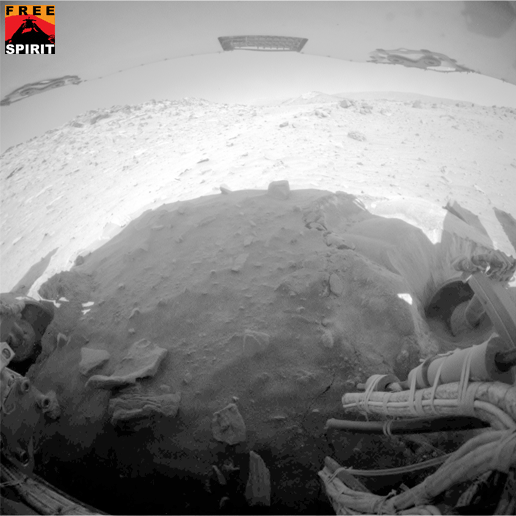Stuck Rover on Mars Climbs Slightly in Escape Attempt

NASA's embattled Mars rover Spirit has managed its first successful, but ever-so-small, climb as it drives in reverse to escape a Martian sand trap that has plagued it for more than eight months.
Spirit lifted itself by nearly half an inch (just over 1 cm) during its latest two drive attempts this month, NASA announced Thursday. While that seems tiny, it's the first upward motion for the rover since escape attempts began in November, the agency added.
The rover also moved about 2.6 inches (6.5 cm) backwards in the maneuvers, which took place on Jan. 14 and Jan. 16. Spirit's left-middle wheel stalled on Tuesday during yet another drive attempt.
"The explanation here is that the rover's rear wheels are climbing, raising the back of the rover," NASA officials said in a statement. "Images from the rear hazard avoidance camera confirm this."
The news comes as NASA engineers run through the short list of remaining options to try and rescue Spirit from the wheel-deep sand it sank into on May 6, 2009. The escape efforts have been on since November, but until now Spirit has only been spinning its wheels forward — towards the north - in attempts to drive itself free.
Now engineers are commanding the rover to spin its wheels in reverse. They are also directing Spirit to turn its wheels from side-to-side every now and then in a so-called "frog kick" maneuver to knock nearby Martian dirt loose and improve traction.
So far, the rover has backtracked across all the forward distance it achieved in the last two months of forward driving attempts.
Get the Space.com Newsletter
Breaking space news, the latest updates on rocket launches, skywatching events and more!
Spirit is now 1.4 inches (3.5 cm) south of its location when the rover began its escape drives in November, mission managers said.
But there is still a long way to go.
Spirit is still stuck in 1.2 inches (3 cm) of Martian sand and its top-mounted solar arrays — vital for generating power — are not in a favorable position to keep the rover alive through a Mars winter. It is currently autumn in the southern hemisphere of Mars, where Spirit is stuck.
The solar arrays need to be tilted substantially to the north in order to collect enough sunlight during a Martian winter. After the Jan. 14 drive, Spirit's northward tilt actually improved by more than a degree only to backslide during the second drive on Jan. 16.
Only four of Spirit's six wheels are working properly. Engineers have also officially ruled out using Spirit's instrument-tipped robotic arm to push the rover free.
Spirit is the size of a golf cart. Its robotic arm is capable of generating only a fraction of the force required to move the rover free of its trap, mission managers said.
"Further, such a technique risks damaging the arm and preventing its use for high-priority science from a stationary rover," NASA officials added.
Spirit is stuck in a part of Mars that scientists have nicknamed "Troy." The area has proven to be filled with interesting rocks and other targets within the reach of Spirit's robotic arm and other instruments.
Still, there are some robotic arm options on the table for the rover. They include using Spirit's arm to push a rock behind or in front of the rover's left-front wheel (the only one it can reach) in order to improve traction.
The arm could also be used to sculpt the Martian sand around that wheel, as well, mission managers said.
Spirit and its robotic twin Opportunity have been exploring Mars since January 2004, when both rovers landed on different parts of the red planet. Unlike Spirit, Opportunity is roving just fine as it heads to a distant, giant crater called Endeavour.
Despite Spirit's current woes, the rover and its twin have far outlasted their initial 90-day missions to explore the red planet, mission managers have said.
NASA also has its collective eyes trained on the northern hemisphere of Mars, which is heading toward springtime, on the off chance that the agency's Phoenix Mars Lander has survived the long, cold Martian winter.
Phoenix landed on Mars on May 25, 2008 and went silent in November 2008. The probe was not built to withstand the full onslaught of a winter on Mars, but is programmed to call Earth just in case it does.
NASA's Mars Odyssey spacecraft currently orbiting the red planet has been listening this week for any signals from Phoenix. More efforts to contact the long-frozen lander are planned through February and March.
Join our Space Forums to keep talking space on the latest missions, night sky and more! And if you have a news tip, correction or comment, let us know at: community@space.com.

Tariq is the Editor-in-Chief of Space.com and joined the team in 2001, first as an intern and staff writer, and later as an editor. He covers human spaceflight, exploration and space science, as well as skywatching and entertainment. He became Space.com's Managing Editor in 2009 and Editor-in-Chief in 2019. Before joining Space.com, Tariq was a staff reporter for The Los Angeles Times covering education and city beats in La Habra, Fullerton and Huntington Beach. In October 2022, Tariq received the Harry Kolcum Award for excellence in space reporting from the National Space Club Florida Committee. He is also an Eagle Scout (yes, he has the Space Exploration merit badge) and went to Space Camp four times as a kid and a fifth time as an adult. He has journalism degrees from the University of Southern California and New York University. You can find Tariq at Space.com and as the co-host to the This Week In Space podcast with space historian Rod Pyle on the TWiT network. To see his latest project, you can follow Tariq on Twitter @tariqjmalik.









